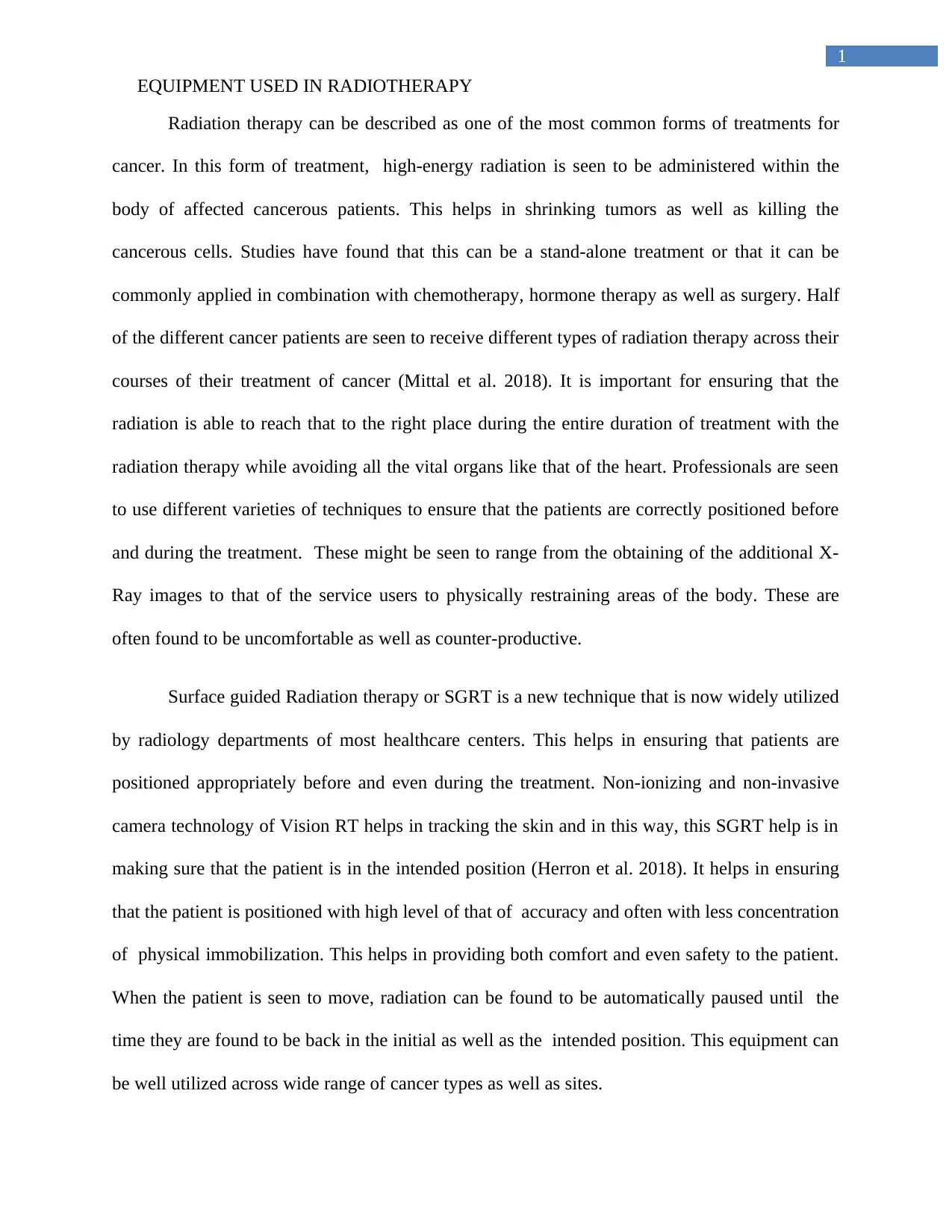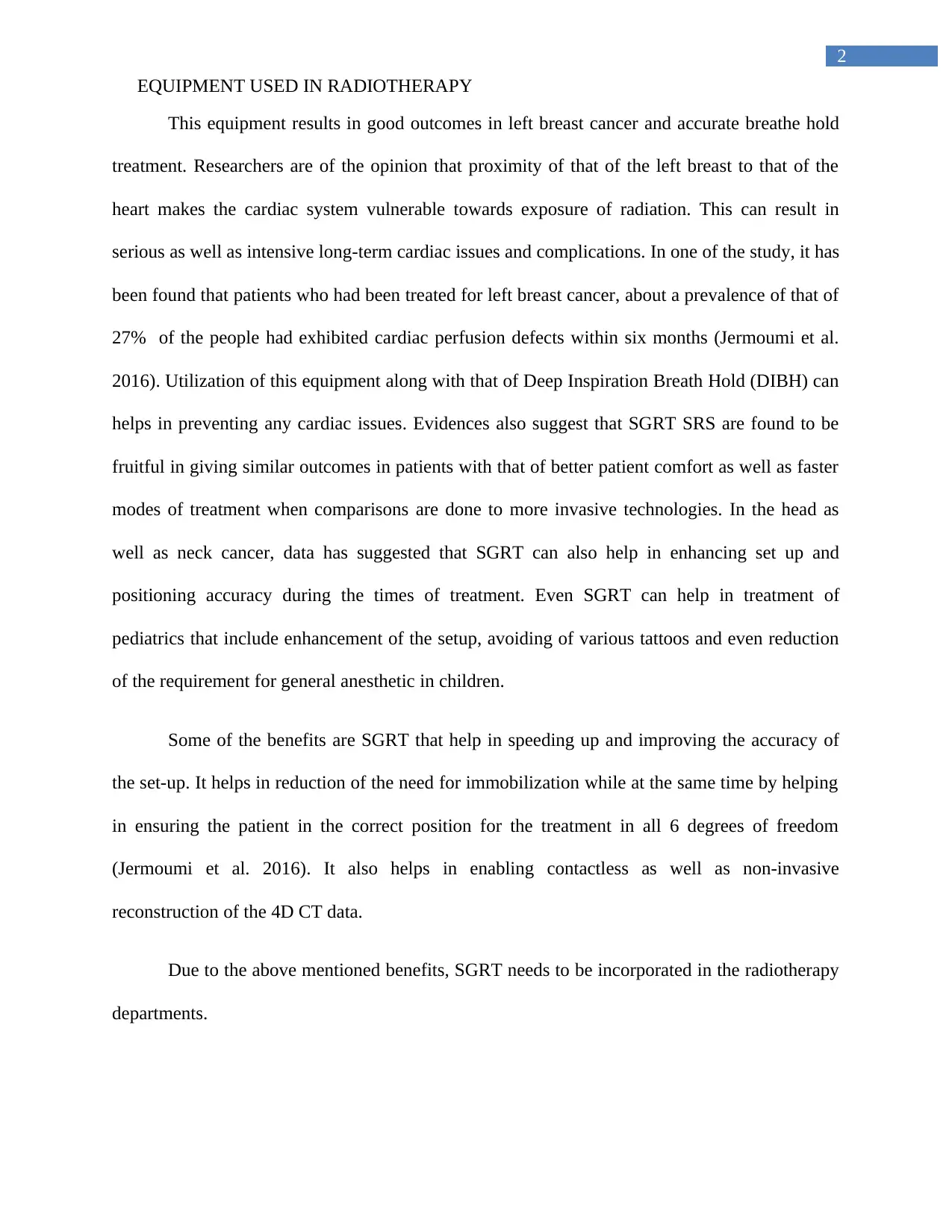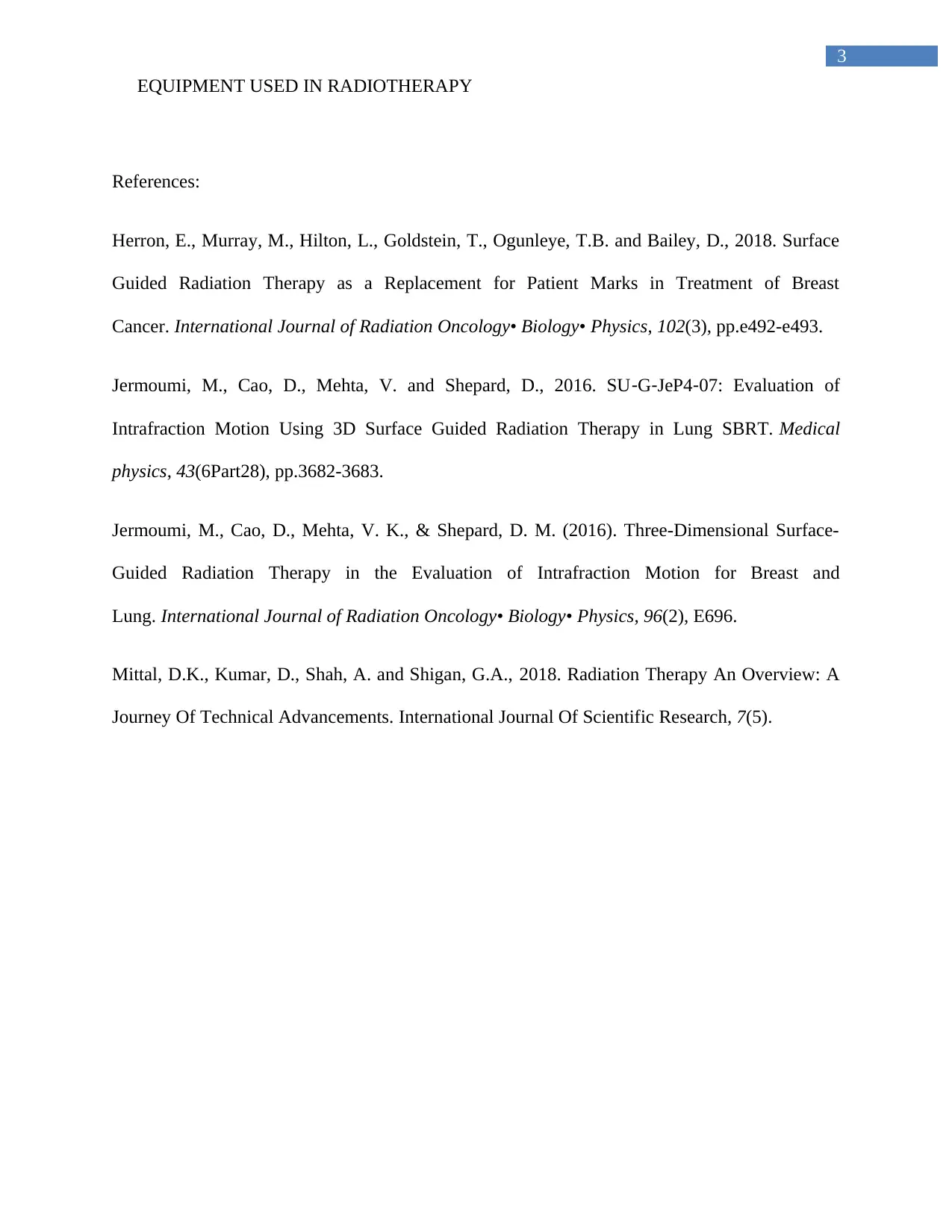Radiotherapy Equipment Report: SGRT and Patient Benefits
VerifiedAdded on 2023/04/25
|4
|942
|428
Report
AI Summary
This report focuses on Surface Guided Radiation Therapy (SGRT), a modern technique used in cancer treatment. SGRT utilizes non-ionizing camera technology to track the patient's skin, ensuring precise positioning before and during radiotherapy, thereby enhancing treatment accuracy and minimizing the risk of radiation exposure to vital organs. This technology is particularly beneficial for cancers like left breast and head and neck cancer, where the proximity to critical structures necessitates precise targeting. SGRT enables contactless 4D CT data reconstruction, reduces the need for immobilization, and can automatically pause radiation if the patient moves, leading to improved patient comfort, safety, and potentially faster treatment times. Studies have shown SGRT can improve treatment outcomes and is increasingly being incorporated into radiotherapy departments worldwide.

Running head: EQUIPMENT USED IN RADIOTHERAPY
EQUIPMENT USED IN RADIOTHERAPY
Name of the student:
Name of the university:
Author note:
EQUIPMENT USED IN RADIOTHERAPY
Name of the student:
Name of the university:
Author note:
Paraphrase This Document
Need a fresh take? Get an instant paraphrase of this document with our AI Paraphraser

1
EQUIPMENT USED IN RADIOTHERAPY
Radiation therapy can be described as one of the most common forms of treatments for
cancer. In this form of treatment, high-energy radiation is seen to be administered within the
body of affected cancerous patients. This helps in shrinking tumors as well as killing the
cancerous cells. Studies have found that this can be a stand-alone treatment or that it can be
commonly applied in combination with chemotherapy, hormone therapy as well as surgery. Half
of the different cancer patients are seen to receive different types of radiation therapy across their
courses of their treatment of cancer (Mittal et al. 2018). It is important for ensuring that the
radiation is able to reach that to the right place during the entire duration of treatment with the
radiation therapy while avoiding all the vital organs like that of the heart. Professionals are seen
to use different varieties of techniques to ensure that the patients are correctly positioned before
and during the treatment. These might be seen to range from the obtaining of the additional X-
Ray images to that of the service users to physically restraining areas of the body. These are
often found to be uncomfortable as well as counter-productive.
Surface guided Radiation therapy or SGRT is a new technique that is now widely utilized
by radiology departments of most healthcare centers. This helps in ensuring that patients are
positioned appropriately before and even during the treatment. Non-ionizing and non-invasive
camera technology of Vision RT helps in tracking the skin and in this way, this SGRT help is in
making sure that the patient is in the intended position (Herron et al. 2018). It helps in ensuring
that the patient is positioned with high level of that of accuracy and often with less concentration
of physical immobilization. This helps in providing both comfort and even safety to the patient.
When the patient is seen to move, radiation can be found to be automatically paused until the
time they are found to be back in the initial as well as the intended position. This equipment can
be well utilized across wide range of cancer types as well as sites.
EQUIPMENT USED IN RADIOTHERAPY
Radiation therapy can be described as one of the most common forms of treatments for
cancer. In this form of treatment, high-energy radiation is seen to be administered within the
body of affected cancerous patients. This helps in shrinking tumors as well as killing the
cancerous cells. Studies have found that this can be a stand-alone treatment or that it can be
commonly applied in combination with chemotherapy, hormone therapy as well as surgery. Half
of the different cancer patients are seen to receive different types of radiation therapy across their
courses of their treatment of cancer (Mittal et al. 2018). It is important for ensuring that the
radiation is able to reach that to the right place during the entire duration of treatment with the
radiation therapy while avoiding all the vital organs like that of the heart. Professionals are seen
to use different varieties of techniques to ensure that the patients are correctly positioned before
and during the treatment. These might be seen to range from the obtaining of the additional X-
Ray images to that of the service users to physically restraining areas of the body. These are
often found to be uncomfortable as well as counter-productive.
Surface guided Radiation therapy or SGRT is a new technique that is now widely utilized
by radiology departments of most healthcare centers. This helps in ensuring that patients are
positioned appropriately before and even during the treatment. Non-ionizing and non-invasive
camera technology of Vision RT helps in tracking the skin and in this way, this SGRT help is in
making sure that the patient is in the intended position (Herron et al. 2018). It helps in ensuring
that the patient is positioned with high level of that of accuracy and often with less concentration
of physical immobilization. This helps in providing both comfort and even safety to the patient.
When the patient is seen to move, radiation can be found to be automatically paused until the
time they are found to be back in the initial as well as the intended position. This equipment can
be well utilized across wide range of cancer types as well as sites.

2
EQUIPMENT USED IN RADIOTHERAPY
This equipment results in good outcomes in left breast cancer and accurate breathe hold
treatment. Researchers are of the opinion that proximity of that of the left breast to that of the
heart makes the cardiac system vulnerable towards exposure of radiation. This can result in
serious as well as intensive long-term cardiac issues and complications. In one of the study, it has
been found that patients who had been treated for left breast cancer, about a prevalence of that of
27% of the people had exhibited cardiac perfusion defects within six months (Jermoumi et al.
2016). Utilization of this equipment along with that of Deep Inspiration Breath Hold (DIBH) can
helps in preventing any cardiac issues. Evidences also suggest that SGRT SRS are found to be
fruitful in giving similar outcomes in patients with that of better patient comfort as well as faster
modes of treatment when comparisons are done to more invasive technologies. In the head as
well as neck cancer, data has suggested that SGRT can also help in enhancing set up and
positioning accuracy during the times of treatment. Even SGRT can help in treatment of
pediatrics that include enhancement of the setup, avoiding of various tattoos and even reduction
of the requirement for general anesthetic in children.
Some of the benefits are SGRT that help in speeding up and improving the accuracy of
the set-up. It helps in reduction of the need for immobilization while at the same time by helping
in ensuring the patient in the correct position for the treatment in all 6 degrees of freedom
(Jermoumi et al. 2016). It also helps in enabling contactless as well as non-invasive
reconstruction of the 4D CT data.
Due to the above mentioned benefits, SGRT needs to be incorporated in the radiotherapy
departments.
EQUIPMENT USED IN RADIOTHERAPY
This equipment results in good outcomes in left breast cancer and accurate breathe hold
treatment. Researchers are of the opinion that proximity of that of the left breast to that of the
heart makes the cardiac system vulnerable towards exposure of radiation. This can result in
serious as well as intensive long-term cardiac issues and complications. In one of the study, it has
been found that patients who had been treated for left breast cancer, about a prevalence of that of
27% of the people had exhibited cardiac perfusion defects within six months (Jermoumi et al.
2016). Utilization of this equipment along with that of Deep Inspiration Breath Hold (DIBH) can
helps in preventing any cardiac issues. Evidences also suggest that SGRT SRS are found to be
fruitful in giving similar outcomes in patients with that of better patient comfort as well as faster
modes of treatment when comparisons are done to more invasive technologies. In the head as
well as neck cancer, data has suggested that SGRT can also help in enhancing set up and
positioning accuracy during the times of treatment. Even SGRT can help in treatment of
pediatrics that include enhancement of the setup, avoiding of various tattoos and even reduction
of the requirement for general anesthetic in children.
Some of the benefits are SGRT that help in speeding up and improving the accuracy of
the set-up. It helps in reduction of the need for immobilization while at the same time by helping
in ensuring the patient in the correct position for the treatment in all 6 degrees of freedom
(Jermoumi et al. 2016). It also helps in enabling contactless as well as non-invasive
reconstruction of the 4D CT data.
Due to the above mentioned benefits, SGRT needs to be incorporated in the radiotherapy
departments.
⊘ This is a preview!⊘
Do you want full access?
Subscribe today to unlock all pages.

Trusted by 1+ million students worldwide

3
EQUIPMENT USED IN RADIOTHERAPY
References:
Herron, E., Murray, M., Hilton, L., Goldstein, T., Ogunleye, T.B. and Bailey, D., 2018. Surface
Guided Radiation Therapy as a Replacement for Patient Marks in Treatment of Breast
Cancer. International Journal of Radiation Oncology• Biology• Physics, 102(3), pp.e492-e493.
Jermoumi, M., Cao, D., Mehta, V. and Shepard, D., 2016. SU‐G‐JeP4‐07: Evaluation of
Intrafraction Motion Using 3D Surface Guided Radiation Therapy in Lung SBRT. Medical
physics, 43(6Part28), pp.3682-3683.
Jermoumi, M., Cao, D., Mehta, V. K., & Shepard, D. M. (2016). Three-Dimensional Surface-
Guided Radiation Therapy in the Evaluation of Intrafraction Motion for Breast and
Lung. International Journal of Radiation Oncology• Biology• Physics, 96(2), E696.
Mittal, D.K., Kumar, D., Shah, A. and Shigan, G.A., 2018. Radiation Therapy An Overview: A
Journey Of Technical Advancements. International Journal Of Scientific Research, 7(5).
EQUIPMENT USED IN RADIOTHERAPY
References:
Herron, E., Murray, M., Hilton, L., Goldstein, T., Ogunleye, T.B. and Bailey, D., 2018. Surface
Guided Radiation Therapy as a Replacement for Patient Marks in Treatment of Breast
Cancer. International Journal of Radiation Oncology• Biology• Physics, 102(3), pp.e492-e493.
Jermoumi, M., Cao, D., Mehta, V. and Shepard, D., 2016. SU‐G‐JeP4‐07: Evaluation of
Intrafraction Motion Using 3D Surface Guided Radiation Therapy in Lung SBRT. Medical
physics, 43(6Part28), pp.3682-3683.
Jermoumi, M., Cao, D., Mehta, V. K., & Shepard, D. M. (2016). Three-Dimensional Surface-
Guided Radiation Therapy in the Evaluation of Intrafraction Motion for Breast and
Lung. International Journal of Radiation Oncology• Biology• Physics, 96(2), E696.
Mittal, D.K., Kumar, D., Shah, A. and Shigan, G.A., 2018. Radiation Therapy An Overview: A
Journey Of Technical Advancements. International Journal Of Scientific Research, 7(5).
1 out of 4
Related Documents
Your All-in-One AI-Powered Toolkit for Academic Success.
+13062052269
info@desklib.com
Available 24*7 on WhatsApp / Email
![[object Object]](/_next/static/media/star-bottom.7253800d.svg)
Unlock your academic potential
Copyright © 2020–2025 A2Z Services. All Rights Reserved. Developed and managed by ZUCOL.





